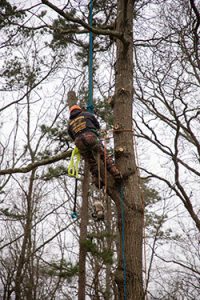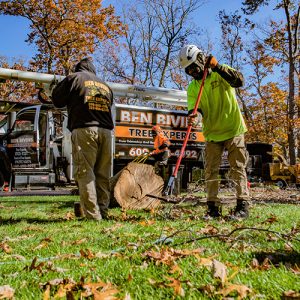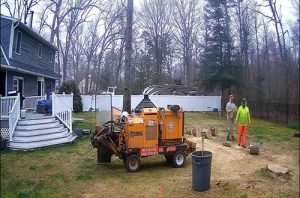Most homeowners call a tree company when they have a problem that needs solving. Maybe there is a dead tree, a leaning pine, or a storm-damaged limb hanging a little too close to the roofline. Now, the view is better and the property is cleaner, but what exactly happens to the tree? The process that takes place next is as important as the removal itself. Disposal, recycling, mulching, and site restoration are all part of the full-service experience that quality Freehold tree companies like Ben Bivins Tree Experts provide. Understanding the behind-the-scenes of what happens after tree removal can help you appreciate the importance of hiring the right company. Let’s walk through what really happens after the chainsaws go quiet, and how your former tree might be turned into something useful, beneficial, and even beautiful.

Step 1. Breaking It All Down
Tree removal doesn’t happen in one fell swoop. The safest way to handle a large tree is to take it apart in sections.
- Cutting of canopy branches is first
- Mid-level limbs follow next
- Creating manageable logs by sectioning the trunk comes next
- Lastly, our tree experts gather smaller twigs, leaves, and brush separately
This organized breakdown allows us to sort the tree into categories: usable wood, wood chips, mulch material, and waste.
Step 2. Chipping and Mulching
One of the most common and sustainable practices among local tree companies is turning brush and smaller limbs into wood chips or mulch. We run branches and smaller limbs through a chipper. The resulting material is used in landscaping, erosion control, or composting. Additionally, many local homeowners even request to keep the mulch for their own garden use. This eco-friendly step reduces landfill waste and gives your former tree a second life as long as the tree is free from pests and diseases. Rest assured, we’ll let you know if this option is safe for your yard.
Step 3. Trunk and Log Disposal
What about the larger sections of trunk? Not every tree produces usable lumber. However, nearly all of it can be repurposed somehow. We handle these heavier logs in several ways:
- Depending on the species, straight sections may be milled into planks or beams for woodworking
- Whether for resale or donation, most tree companies in Freehold cure and cut hardwood logs for firewood
- If not viable for lumber or firewood, coarse mulch is an option for some logs
- Many municipalities in New Jersey accept tree waste as part of green recycling programs
Stump 4. Stump Grinding or Removal
The stump is the last part to handle. Stump grinding is the most common method. A large blade grinds the stump down 4–6 inches below soil level. Complete stump removal is more labor-intensive, involving excavation of roots and base. The mulch created during stump grinding is left behind or hauled away, depending on the homeowner’s preference. The remaining area can be treated however the homeowner wants. For example, soil can be leveled and seeded, the area can be prepped for a new tree, or a new garden bed can be created.
Step 5. Cleaning the Site
Professionalism doesn’t stop at tree removal. One of the things that sets top-tier Freehold tree companies apart is how they leave your property once the work is complete. After tree breakdown and disposal, our experts rake and clear away all debris as well as blowing clean driveways, sidewalks, and patios. Next, the work area is inspected and equipment tracks are minimized or repaired. The result is that your yard is safer and often healthier than before. Many homeowners are surprised to see how much cleaner and more open their property feels after proper removal and cleanup.
 Not All Freehold Tree Companies are Created Equal
Not All Freehold Tree Companies are Created Equal
When you’re researching Freehold tree companies, consider more than just the price of the job. Ask what happens after the cut. A truly professional company will provide safe removal, respectful cleanup, and responsible disposal. At Ben Bivins Tree Experts, we’ve built a reputation on quality, honesty, and a commitment to the environment. Whether it’s a hazard tree, a dying oak, or just a backyard spruce that is overgrown—we’ll treat your tree with the care it deserves from start to finish.
Contact Us Today!
When you think about trees damaging property, you probably picture falling limbs or downed trunks after a storm. But threats to your home can also come from underground. Tree roots, though often overlooked, can have a serious impact on your home’s foundation over time. While trees offer shade, beauty, and property value, they must be placed and maintained thoughtfully to prevent long-term structural damage. Homeowners in coastal areas, such as Little Egg Harbor, face unique soil conditions that make this topic even more important. In this article, we’ll explore how tree roots grow, the warning signs of root-related foundation damage, and what steps you can take to protect your property. The safest and easiest way to ensure both your trees and your home stay healthy is to contact Ben Bivins Tree Experts, an experienced tree company in Little Egg Harbor.
How Tree Roots Affect Your Home
Tree roots are constantly on the hunt for water and nutrients. In doing so, they tend to grow laterally through the top few feet of soil, extending outward far beyond the canopy of the tree itself. If your home’s foundation is nearby, these roots may begin to encroach upon it. Contrary to popular belief, roots don’t typically “crack” concrete. Instead, they exploit pre-existing weaknesses—small fissures, gaps, or areas where the soil has shifted—slowly causing pressure that leads to foundation issues.
In sandy or clay-rich soils, like those found throughout Ocean County, the problem can be exacerbated. As roots absorb moisture, the surrounding soil may shrink or settle unevenly, contributing to shifts in the foundation. Over time, this can lead to doors that no longer close properly, cracks in walls, or even visible warping in the structure.
Signs That Roots May Be Affecting Your Foundation
 Many signs of root-related damage are subtle at first. Being proactive is key, especially if you have large, mature trees near your home. Here are some common symptoms to look for:
Many signs of root-related damage are subtle at first. Being proactive is key, especially if you have large, mature trees near your home. Here are some common symptoms to look for:
- Cracks in your foundation walls, especially ones that widen over time
- Uneven floors or visible sinking around the perimeter of your home
- Doors or windows that stick or no longer align
- Buckling concrete in sidewalks, patios, or driveways near large trees
- Water pooling or unusual drainage patterns near your foundation
If you spot any of these issues, it’s time to consult not only a structural expert, but also a tree company in Little Egg Harbor. A thorough assessment can determine if roots are the culprit—and what to do about them.
How to Prevent Tree Root Damage
Prevention begins long before a tree causes a problem. If you’re planting new trees, consider their mature size and how far their root systems may eventually reach. A general rule of thumb is to plant trees at least as far away from your foundation as the expected height of the tree. For example, a tree that will grow to be 40 feet tall should be at least 40 feet from your home.
For existing trees, root pruning, barrier installation, or guided growth techniques may help. In some cases, especially where the tree is already compromising the foundation, removal may be the best option. However, this decision should never be made lightly. Trees offer environmental benefits and value, and a skilled arborist can help you weigh your options.
Why Professional Help Is Essential
Attempting to cut roots or remove trees near a home without proper knowledge and equipment can result in unintended consequences. Severing roots improperly can destabilize a tree, increasing the risk of it falling during a storm. In other cases, roots may regrow aggressively or cause problems in other areas.
That’s why working with a qualified tree company in Little Egg Harbor is critical. Local professionals understand how native trees behave, how the soil interacts with roots, and how to assess threats to nearby structures. They have the tools and training to perform root evaluations, create long-term care plans, and take action safely if needed.

Protect Your Home and Your Trees
Your home’s foundation is one of its most important structural components. Protecting it means being vigilant not just above ground, but below the surface as well. Trees and homes can coexist peacefully when thoughtful care is taken from the start and when issues are addressed early.
If you’re unsure about the impact of nearby trees on your home, reach out to a tree company in Little Egg Harbor like Ben Bivins Tree Experts. With years of experience serving the coastal communities of New Jersey, we’re here to help you preserve the beauty of your trees without compromising your property’s safety.

